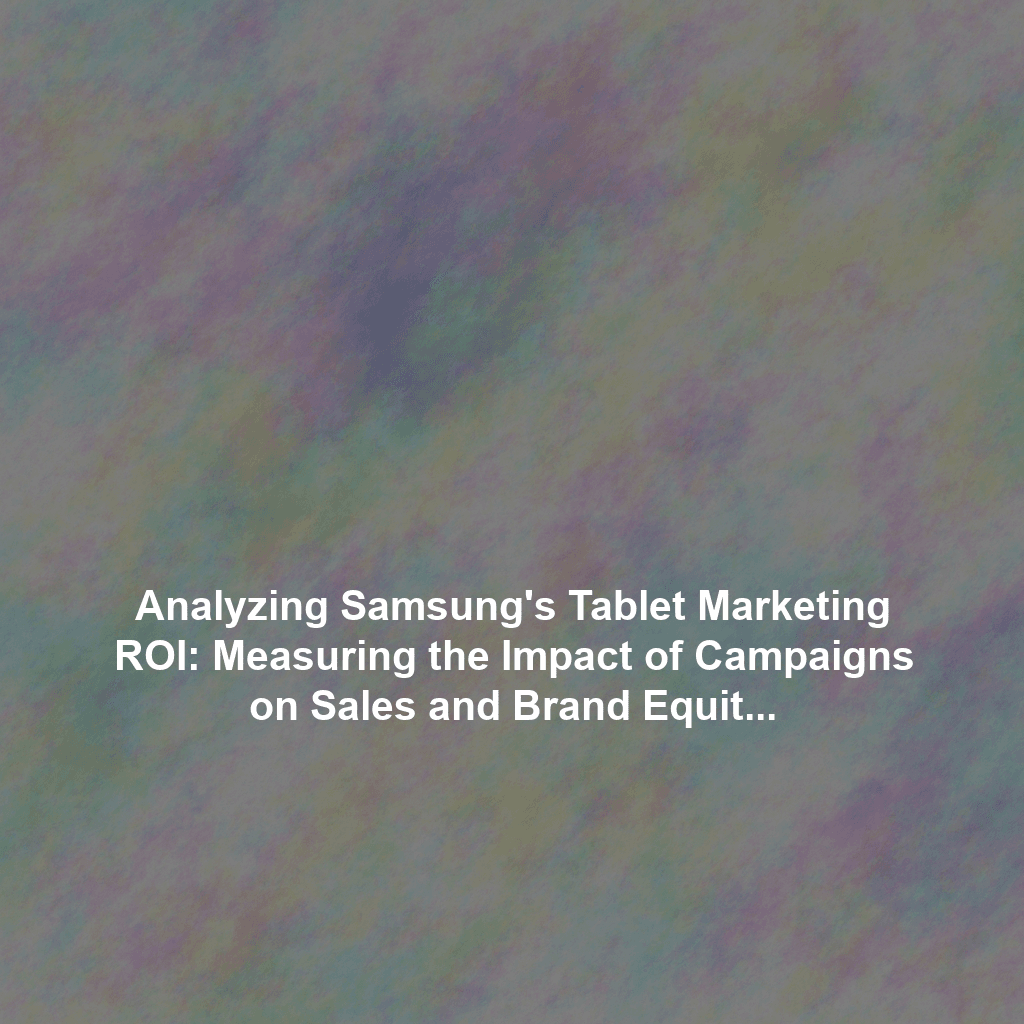Samsung, a global tech titan, consistently innovates in the tablet market, launching devices like the Galaxy Tab S9 series that blend powerful performance with sleek design. But creating a compelling product is only half the battle. The real challenge lies in effectively marketing these devices to a diverse consumer base and, crucially, understanding the return on investment (ROI) from those marketing efforts. This article delves into how Samsung likely approaches measuring the impact of its tablet marketing campaigns, exploring the key performance indicators (KPIs) they might track and the strategies employed to attribute success to specific marketing activities. While direct internal data from Samsung is confidential, we can extrapolate from industry best practices and publicly available information to paint a comprehensive picture.
Understanding the Landscape: Samsung’s Tablet Marketing Strategy
Samsung’s tablet marketing strategy is multifaceted, typically encompassing a blend of:
- Digital Marketing: Search engine optimization (SEO), pay-per-click (PPC) advertising, social media marketing, email campaigns, and content marketing.
- Traditional Marketing: Television commercials, print advertisements (though less common now), and out-of-home advertising.
- Partnerships and Influencer Marketing: Collaborations with retailers, mobile carriers, and influential tech reviewers.
- Product Placement: Featuring tablets in movies, TV shows, and other media.
- Experiential Marketing: Product demos at trade shows, in-store displays, and pop-up events.
Each of these channels requires a distinct approach to measuring ROI.
Key Performance Indicators (KPIs) for Samsung’s Tablet Marketing
To accurately assess the impact of its marketing investments, Samsung likely tracks a range of KPIs:
Website Traffic and Engagement
Increased website traffic, particularly to tablet product pages, is a primary indicator. Samsung likely uses tools like Google Analytics (or similar analytics platforms) to monitor:
- Pageviews and Unique Visitors: Measuring the overall reach of website content.
- Bounce Rate: Identifying pages that are not engaging visitors.
- Time on Page: Assessing how long visitors spend consuming content.
- Conversion Rates: Tracking the percentage of visitors who take a desired action, such as adding a tablet to their cart or requesting a quote.
Lead Generation
Lead generation is crucial for capturing potential customers and nurturing them through the sales funnel. KPIs related to lead generation include:
- Number of Leads Generated: Tracking the volume of inquiries, sign-ups, and other forms of lead capture.
- Lead Quality: Evaluating the likelihood of a lead converting into a paying customer (e.g., through lead scoring).
- Cost Per Lead: Calculating the cost of acquiring each lead.
Sales and Revenue
Ultimately, the success of any marketing campaign is measured by its impact on sales and revenue. Samsung likely tracks:
- Tablet Sales Volume: Monitoring the number of tablets sold during and after a campaign.
- Revenue Generated: Tracking the total revenue earned from tablet sales.
- Average Order Value: Calculating the average amount spent per tablet purchase.
- Sales Conversion Rate: The percentage of website visitors or leads that ultimately become paying customers.
Brand Mentions and Sentiment
Brand equity is a valuable asset. Monitoring brand mentions and sentiment helps gauge the overall perception of Samsung tablets. KPIs include:
- Number of Brand Mentions: Tracking the frequency of mentions of Samsung tablets across social media, news articles, and other online platforms.
- Sentiment Analysis: Assessing the positive, negative, or neutral sentiment associated with brand mentions.
- Share of Voice: Comparing Samsung’s brand mentions to those of its competitors.
Attribution Modeling: Connecting Marketing Activities to Results
Attributing success to specific marketing activities is a complex challenge. Samsung likely employs various attribution models to understand the customer journey and identify the touchpoints that contributed most to a sale. Common attribution models include:
- First-Touch Attribution: Giving credit to the first marketing interaction a customer had with the brand.
- Last-Touch Attribution: Giving credit to the last marketing interaction before a purchase.
- Linear Attribution: Distributing credit equally across all touchpoints.
- Time-Decay Attribution: Giving more credit to touchpoints closer to the purchase.
- Algorithmic Attribution: Using machine learning to determine the optimal weighting of each touchpoint based on historical data.
Samsung likely uses a combination of these models to gain a comprehensive understanding of the customer journey. They may also use marketing automation platforms that provide attribution modeling features, helping them to understand which campaigns are driving the most valuable leads and sales.
Best Practices for Measuring Marketing Effectiveness in the Tablet Market
Measuring marketing effectiveness in the tablet market requires a strategic and data-driven approach. Here are some best practices:
- Set Clear Goals and Objectives: Define specific, measurable, achievable, relevant, and time-bound (SMART) goals for each marketing campaign.
- Track the Right KPIs: Focus on the KPIs that are most relevant to the campaign’s objectives.
- Use Advanced Analytics Tools: Leverage tools like Google Analytics, Adobe Analytics, and marketing automation platforms to track and analyze data.
- Implement A/B Testing: Test different versions of marketing materials (e.g., ad copy, landing pages) to identify what resonates best with the target audience.
- Regularly Review and Optimize: Continuously monitor campaign performance and make adjustments as needed to improve results.
- Consider External Factors: Be aware of external factors, such as economic conditions, competitor activity, and seasonality, that can influence sales and marketing effectiveness.
Conclusion
Measuring the ROI of tablet marketing campaigns is essential for Samsung to optimize its marketing investments and drive profitable growth. By tracking key performance indicators, employing sophisticated attribution models, and adhering to best practices, Samsung can gain a clear understanding of what’s working, what’s not, and how to allocate resources effectively. While the specifics of Samsung’s internal processes remain confidential, the principles outlined above offer a valuable framework for understanding how a leading tech company likely approaches marketing measurement in the competitive tablet market. This ultimately allows Samsung to refine its strategies, strengthen its brand, and stay ahead in the ever-evolving world of consumer technology.
 Skip to content
Skip to content

